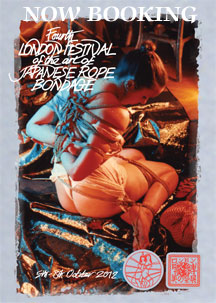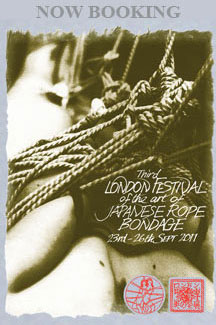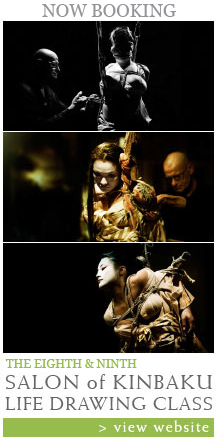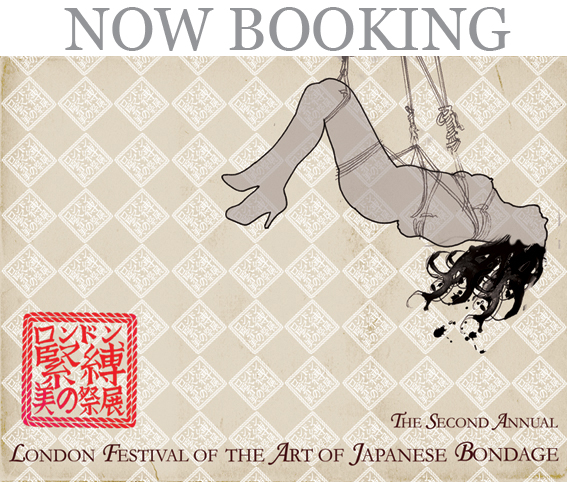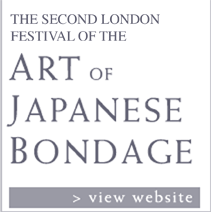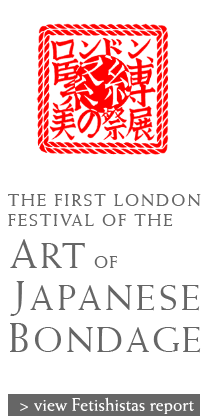Forum magazine interview
FORUM magazine, volume 39 No 1 04
pp36-42
Jon Blake, also known as Nawashi Murakawa, studied for an Illustration degree at the Liverpool College of Arts in the Sixties, following this with an MA in Film and TV at the Royal College of Art. He works as a freelance illustrator, woodcut artist and engraver, makes props and sets, has worked on films and fashion shows and is currently designing a fashion collection. Now 56, he is known and respected internationally as a master nawashi (rope artist) of kinbaku (the art of Japanese bondage) and shares top billing with other nawashi at Japanese clubs. He also produces stunning photographs of his art and is currently working with Swiss publisher Edition Skylight to produce his book, The Ten Women.
Forum: When did you develop an interest in Japanese rope bondage?
Murakawa: It started ten years ago, when I had my first Japanese girlfriend. We didn't actually try rope bondage together. In fact, I had no knowledge or awareness of it at that time. However, the experience of knowing her started my interest, in traditional Japanese culture, essential to understand the art form. I started to see the world in a different way, as the Japanese see it, especially their careful and controlled understanding of natural things. It's a sense of stylised beauty. I've been told I have kokoro - a special state of mind, a feeling in my heart for things Japanese, its people, its land and mythology. Specifically it's the traditional culture that attracts me - the spiritual and aesthetic aspects, the ritual and philosophy. Their culture is 2500 years old and has developed in a very pure way. I like the older Japanese films, such as Tokyo Story (1953) directed by Yasujiro Ozu, because they teach you so much about how the Japanese think. When my girlfriend left, I felt a deep sense of loss, not only for her but also the culture she'd brought with her. I found myself alone and yet driven to explore the culture further, and my awareness of Japanese rope bondage came as a passion and a possession. It was as if I was trying to keep that culture of Japan alive within me by tying things in a manner that brought a real Japan right into the intense proximity of my ordinary home life, as though the special kami (spirits) had flown around the earth and come to me to give me a precious gift of rope skills and understanding. This was the starting point that lead me to a whole new way of life and thinking. Then a Japanese friend gave me a copy of the best-selling magazine SM Sniper, which I have since appeared in five times as an accepted practitioner of rope bondage in their style. I remember I looked at the magazine and knew instantly I could do this, because of my knowledge, skills and good hands.
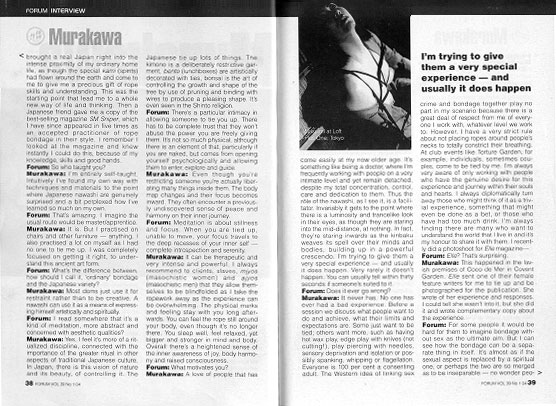 |
Forum: So who taught you?
Murakawa: I'm entirely self-taught. Intuitively I've found my own way with techniques and materials to the point where Japanese nawashi are genuinely surprised and a bit perplexed how I've learned so much on my own.
Forum: That's amazing. I imagine the usual route would be master/apprentice.
Murakawa: It is. But I practised on chairs and other furniture - anything. I also practised a lot on myself as I had no one to tie me up. I was completely focused on getting it right, to understand this ancient art form.
Forum: What's the difference between, how should I call it, 'ordinary' bondage and the Japanese variety?
Murakawa: Most doms just use it for restraint rather than to be creative. A nawashi can use it as a means of expressing himself artistically and spiritually.
Forum: I read somewhere that it's a kind of meditation, more abstract and concerned with aesthetic qualities?
Murakawa: Yes, I feel it's more of a ritualized discipline, connected With the importance of the greater ritual in other aspects of traditional Japanese culture. In Japan, there is this vision of nature and its beauty, of controlling it. The Japanese tie up lots of things. The, kimono is a deliberately restrictive garment, bento (lunchboxes) are artistically decorated with ties, bonsai is the art of controlling the growth and shape of the tree by use of pruning and binding with wires to produce a pleasing shape. It's even seen in the Shinto religion.
Forum: There's a particular intimacy in allowing someone to tie you up. There has to be complete trust that they won't abuse the power you are freely giving them. It's not so much physical, although there is an element of that, particularly if you are naked, but comes from opening yourself psychologically and allowing them to enter, explore and guide.
Murakawa: Even though you're restricting someone you're actually liberating many things inside them. The body map changes and-their focus becomes inward. They often encounter a previously undiscovered sense of peace and harmony on their inner journey.
Forum: Meditation is about stillness and focus. When you are tied up, unable to move, your focus travels to the deep recesses of your inner self complete introspection and serenity.
Murakawa. It can be therapeutic and very intense and powerful. I always recommend to clients, slaves, mjyos (masochistic women) and ajyos (masochistic men) that they allow themselves to be blindfolded as I take the ropework away as the experience can be overwhelming. The physical marks and feeling stay with you long afterwards. You can feel the rope still around your body, even though it's no longer there. You sleep well, feel relaxed, yet bigger and stronger in mind and body. Overall there's a heightened sense of the inner awareness of joy, body harmony and raised consciousness.
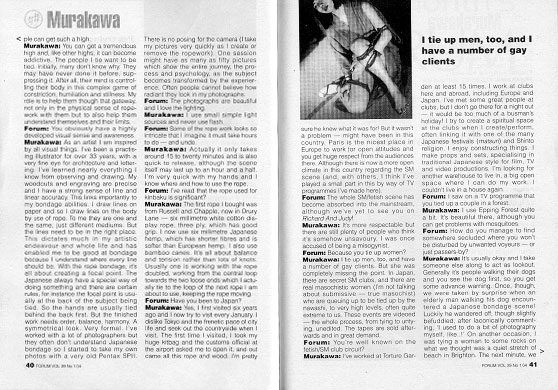 |
Forum: What motivates you?
Murakawa: A love of people that has come easily at my now older age. It's something like being a doctor, where I'm frequently working with people on a very intimate level and yet remain detached, despite my total concentration, control, care and dedication to them. Thus the role of the nawashi, as I see it, is a facilitator. Invariably it gets to the point where there is a luminosity and trancelike look in their eyes, as though they are staring into the mid-distance, at nothing. in fact, they're staring inwards as the kinbaku weaves its spell over their minds and bodies, building up in a powerful crescendo. I'm trying to,give them a very special experience - and usually it does happen. Very rarely it doesn't happen. You can usually tell within thirty seconds if someone's suited to it.
Forum: Does it ever go wrong?
Murakawa: It never has. No one has ever had a bad experience. Before a session we discuss what people want to do and achieve, what their limits and expectations are. Some just want to be tied; others want more, such as having hot wax play, edge play with knives (not cutting!), play piercing with needles, sensory deprivation and isolation or possibly spanking, whipping or flagellation. Everyone is 100 per cent a consenting adult. The Western idea of linking sex crime and bondage together play no part in my scenario because there is a great deal of respect from me of everyone I work with, whatever level we work to. However, I have a very strict rule about not placing ropes around peoples necks to totally constrict their breathing. At club events like Torture Garden, for example, individuals, sometimes couples, come to be tied by me. I'm always very aware of only working with people who have the genuine desire for this experience and journey.within their souls and hearts. I always diplomatically turn away those who might think of it as a trivial experience, something that might even be done as a bet, or those who have had too much drink. I'm always finding there are many who want to understand the world that I live in and it's my honour to share it with them. I recently did a photoshoot for Elle magazine -
Forum: Elle? That's surprising.
Murakawa: This happened in the lavish premises of Coco de Mer in Covent Garden. Elle sent one of their female feature writers for me to tie up and be, photographed for the publication. She wrote of her experience,and responses. I could tell she wasn't into it, but she did it and wrote complementary copy about the experience.
Forum: For some people it would be hard for them to imagine bondage without sex as the ultimate aim. But I can see how the bondage can be a separate thing in itself. It's almost as if the sexual aspect is replaced by a spiritual one, or perhaps the two are so merged as to be inseparable - no wonder peo-
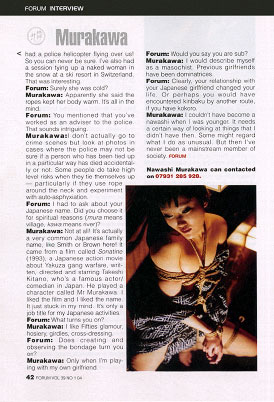 |



